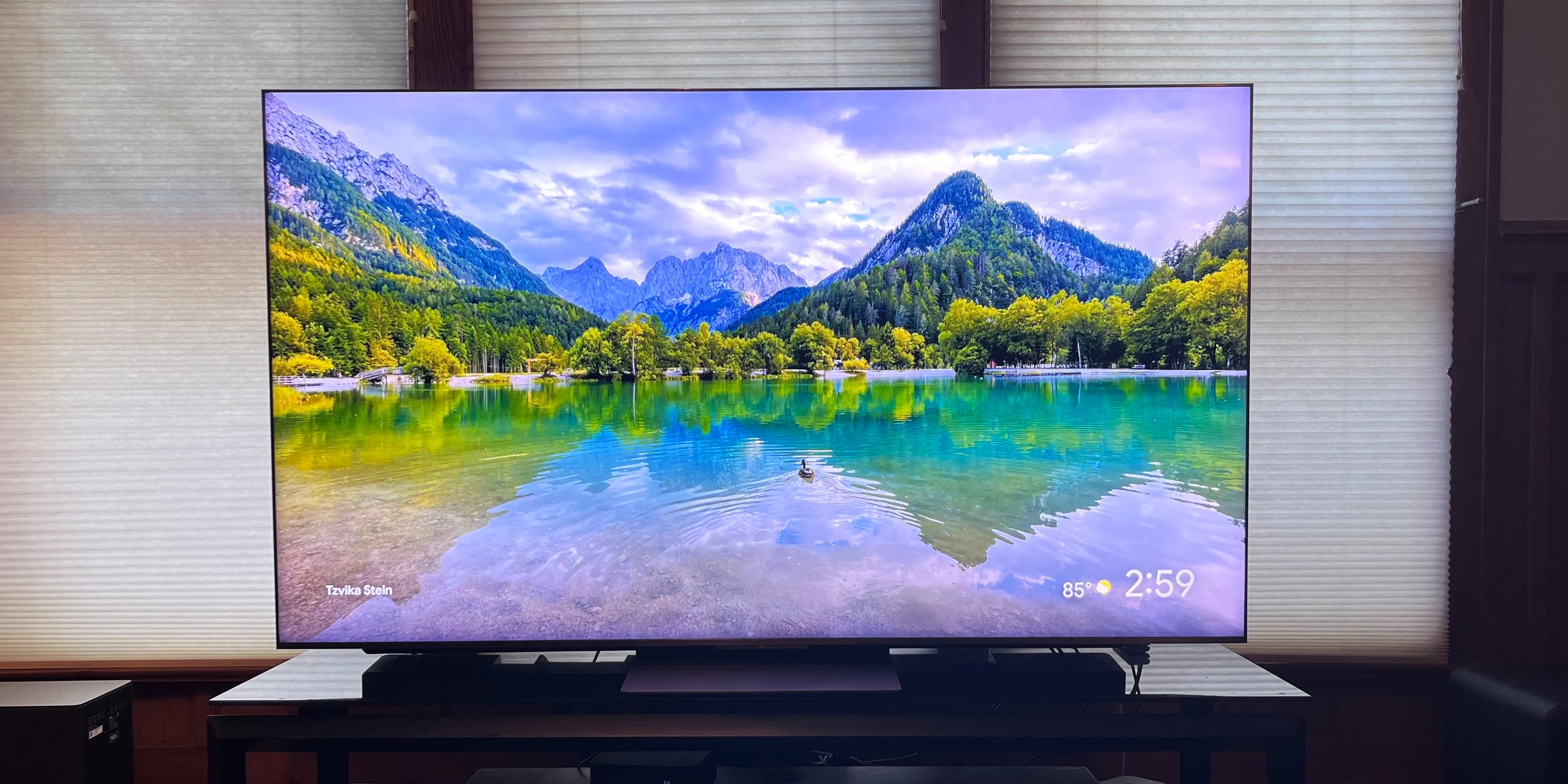TechRadar Verdict
The TCL QM8K is a marked improvement over its predecessor, with refined local dimming for solid, ‘halo-free’ blacks, and a new Ultra Wide Angle feature that ensures pictures look equally good from a range of viewing positions. The Dolby Atmos speaker system delivers sound that is better than average, although it is somewhat light on bass. The Google TV software is serviceable, and it has a good selection of gaming features, including 4K 144Hz support. Value is perhaps the strongest suit of the QM8K, which offers very solid picture quality, sleek design, and useful features at a lower price than the premium competition.
Pros
- +
High brightness
- +
Solid, halo-free blacks
- +
Dolby Vision and HDR10+ support
Cons
- -
Only two HDMI 2.1 ports
- -
Slight vignetting effect
Why you can trust TechRadar
TCL QM8K: Two-minute review
The TCL QM8K is the company’s flagship mini-LED TV for 2025, and it brings several refinements over last year’s TCL QM851G, which was the brightest TV we’d ever tested at the time. The QM8K also delivers high brightness via a new Super High Energy LED Chip. Still, that brightness is now balanced with a Halo Control System, a 23-bit backlight controller, and a Dynamic Light Algorithm to ensure that pictures also have solid contrast and deep, detailed shadows.
The improvements made to the TCL QM8K make it one of the best TVs for movies, but its anti-reflection screen and new Ultra Wide Angle feature also make it perfect for sports. Not only do you get a very bright picture, but its anti-reflection coating lets you watch without having to worry about screen glare, while the Ultra Wide Angle feature means that groups can gather around the screen and everyone will experience the same picture quality no matter where they are sitting.
TCL tapped speaker Danish speaker maker Bang & Olufsen to design the QM8K’s built-in speaker system, which supports both Dolby Atmos and DTS Virtual:X. Audio by Bang & Olufsen on the QM8K entails a ‘Beosonic’ equalization interface that lets you tune the sound using categories like Bright or Relaxed, as opposed to typical EQ options. Overall, the QM8K’s built-in sound is good for a TV, though it’s unsurprisingly light on bass and dynamics.
The QM8K’s Ultra Slim design uses a Zero Border bezel that reduces the distance between the TV’s edge and the actual picture to a mere 3.4mm. It has a more premium look than many TVs, and models up to 85 inches all get a sturdy pedestal stand with adjustable height to clear space for a soundbar.
Google TV is used for the QM8K’s smart TV platform, and it’s a serviceable one, but also one that serves up ads. A quick menu lets you easily access basic picture and other settings, and Google TV’s Live program guide can incorporate broadcast channels pulled in by the QM8K’s ATSC 3.0 ‘NextGen TV’ tuner.
Gaming is well represented on the QM8K with 4K 144Hz support, though that refresh rate is only supported on two of the TV’s four HDMI ports. A Game Accelerator 288 VRR feature also lets you double the TV’s native 144Hz refresh rate for 1080p resolution gaming. The QM8K’s 13.2ms input lag would be considered an average level for most TVs, though most gamers should be perfectly satisfied with its gaming performance.
Value is a strong point with the QM8K. TCL’s current discounted $1,599 price for the 65-inch model is several hundred dollars less than the 65-inch Samsung QN90F, and it offers many of the same features, including an anti-reflection screen and Ultra Wide Angle feature. But it's also more expensive than the Hisense U8QG, another super-bright mini-LED TV with impressive picture quality.
Sign up for breaking news, reviews, opinion, top tech deals, and more.
TCL QM8K review: Price and release date
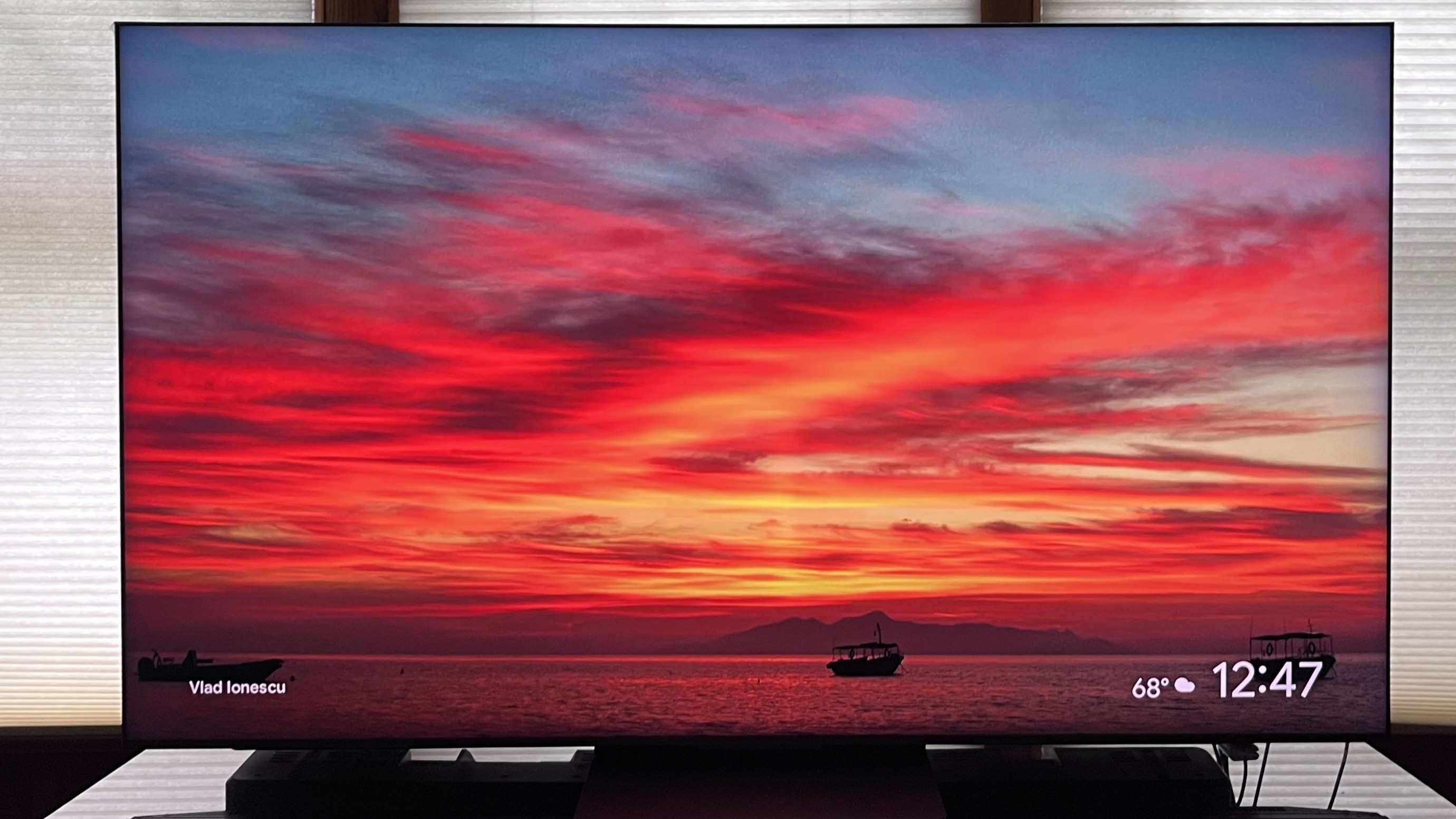
- Release date: May 2025
- 65-inch: $2,499.99
- 75-inch: $3,199.99
- 85-inch: $3,799.99
- 98-inch: $6,499.99
Similar to its TCL QM851G predecessor, the new TCL QM8K series is available in 65- to 98-inch screen sizes. All QM8K sizes launched at a higher list price than the preceding models, but have since dropped significantly, with the 65-inch version I tested now widely selling for $1,599.
With its reduced pricing, the QM8K is now more competitive with the Hisense U8QG, which is that company’s flagship mini-LED TV series. The 65-inch U8QG dropped to $1,299 during the time I was reviewing the TCL QM8K. Another close mini-LED competitor for the QM8K is the Samsung QN90F, a 2025 model that has since dropped in price to $1,999 for the 65-inch model.
TCL QM8K review: Specs
Screen type: | QLED with mini-LED |
Refresh rate: | 144Hz |
HDR support: | Dolby Vision, HDR10+, HDR10, HLG |
Audio support: | Dolby Atmos, DTS Virtual:X |
Smart TV: | Google TV |
HDMI ports: | 4 (2x HDMI 2.1) |
Built-in tuner: | ATSC 3.0 |
TCL QM8K review: Benchmark results
Hisense U8QG review: Features
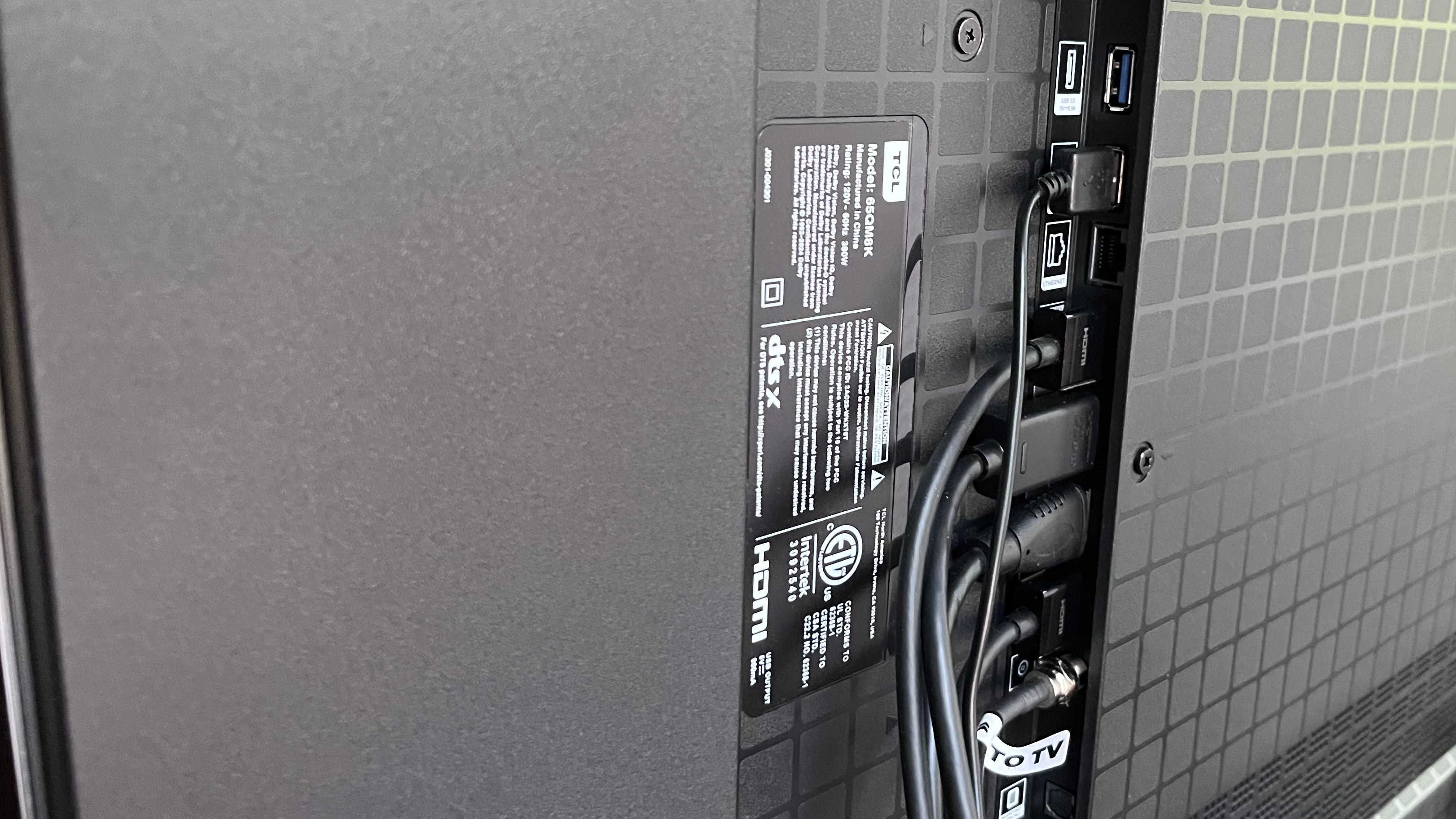
- Ultra Wide Viewing Angle
- Dolby Vision IQ, HDR10+, HDR10, and HLG support
- Audio by Bang & Olufsen
The TCL QM8K series uses a new CrystGlow WHVA Panel with TCL’s Halo Control System. To decipher all that, it’s a QLED display with a mini-LED backlight that uses a Super High Energy LED Chip for increased brightness, along with a reduced optical distance between the light modules and display panel. The Halo Control System in QM8K series TVs also feature a 23-bit backlight controller for more precise local dimming, which is helped by a Dynamic Light Algorithm.
Two other CrystGlow WHVA Panel features are a Zero Border display that reduces the distance between the TV’s edge to the actual image down to 3.4mm, and Ultra Wide Viewing Angle, which provides a 40% improvement in off-axis picture uniformity compared to last year’s TCL QM851G series, according to TCL.
QM8K series TVs feature up to 3,800 local dimming zones and up to 5,000 nits specified brightness. An anti-reflective screen is also provided to reduce screen glare when viewing in bright rooms.
HDR support on the QM8K series includes the Dolby Vision IQ, HDR10+, HDR10, and HLG formats. The TVs are also IMAX Enhanced and they provide a Filmmaker Mode picture preset – a new feature for TCL TVs in 2025.
The Audio by Bang & Olufsen built-in speaker system on QM8K series TVs supports Dolby Atmos and DTS Virtual:X. No specific speaker configuration or wattage information is supplied in TCL’s specifications, but there are upfiring Atmos speakers on the TV’s top edge, along with dual subwoofers on the rear panel.
Like other TCL TVs, the QM8K series uses the Google TV smart TV platform, and it also features a built-in mic for hands-free Google Assistant voice control. If you don’t want to deal with Google Assistant, other control options include Amazon Alexa and Apple HomeKit.
Gaming features on the QM8K include 4K 144Hz support on two of the TV’s four HDMI inputs. A Game Accelerator 288 VRR feature lets you double the TV’s native 144Hz refresh rate to 288Hz for 1080p-resolution gaming, and there’s also a Game Bar menu for easy onscreen access to gaming-related adjustments.
The QM8K’s connections include an ATSC 3.0 tuner input. This lets you connect one of the best indoor TV antennas to receive both standard and ‘NextGen’ digital TV broadcast channels, and there are options to view channel data either in a dedicated program grid guide or integrated in the Google TV Live TV guide along with free streaming channels.
- Features Score: 4.5/5
TCL QM8K review: Picture quality
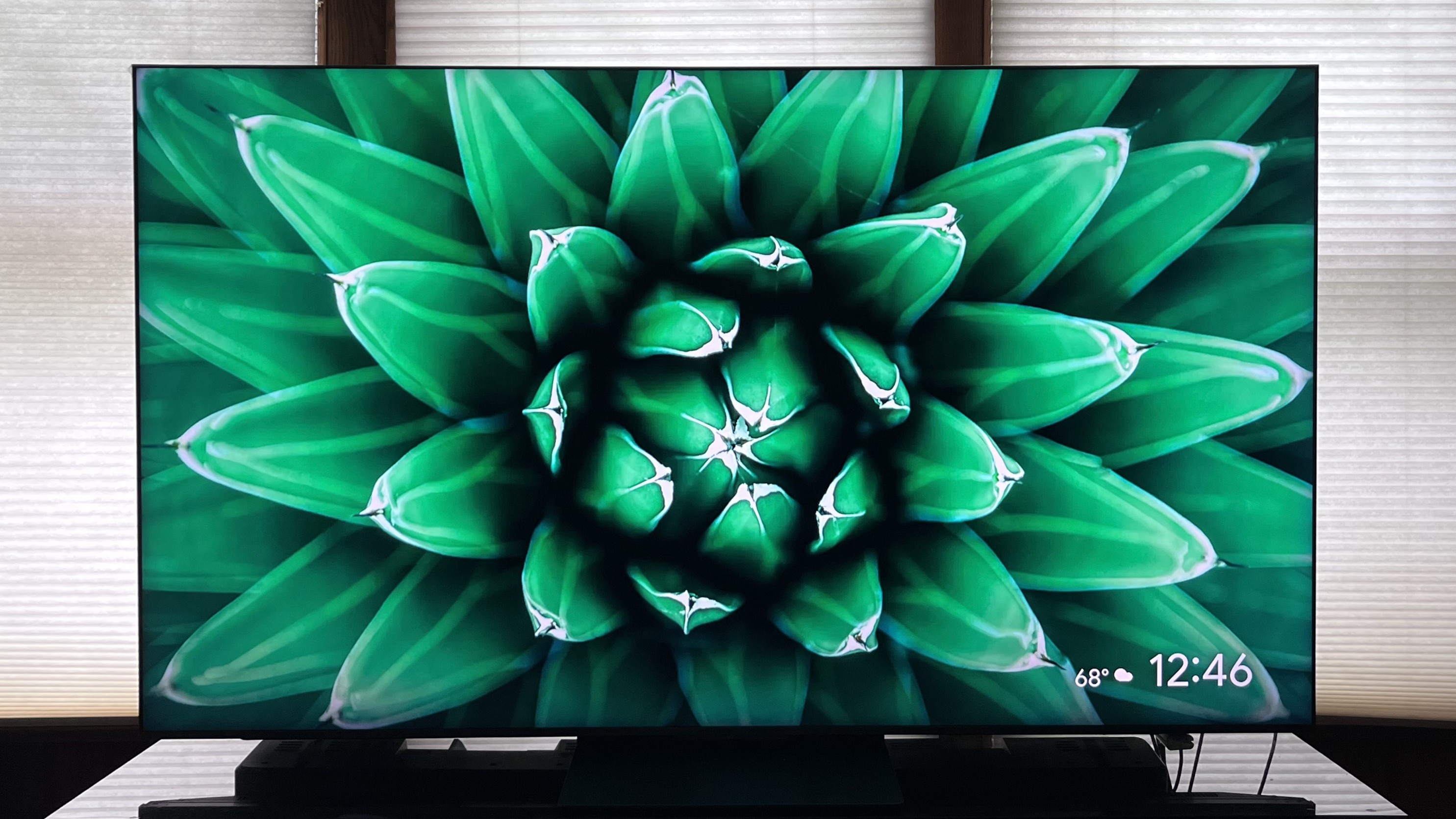
- Excellent brightness
- Accurate out-of-the-box picture
- Impressive off-center picture uniformity
When I tested the QM8K’s predecessor, the TCL QM851G, it was the brightest TV I’d yet measured. The QM8K doesn’t hit the same brightness heights as that model, but it still has very high brightness even by flagship mini-LED TV standards.
In Filmmaker Mode, the QM8K hit 2,268 nits peak brightness (measured on a 10% HDR white window pattern) and 584 nits fullscreen brightness. Standard mode brightness was even higher, at 3,176 and 629 nits, respectively.
For comparison’s sake, the Samsung QN90F measured 2,086 and 667 nits, respectively, on the same tests in Movie mode when I reviewed it, while the Hisense U8QG – 2025’s current reigning brightness king – hit 2,888 nits peak brightness and 744 nits fullscreen brightness in my tests.
Color gamut coverage was also excellent, with the QM8K measuring 97% for UHDA-P3 and 78.7% for BT.2020. Picture accuracy was also notably good, with the QM8K delivering Delta-E (the margin of error between the test pattern source and what’s shown on-screen) averages of 1.9 for grayscale and 0.8 for color, which means both are indistinguishable from perfect to the human eye.
The QM8K features an Intelligent picture preset that uses AI to determine the proper picture settings based on content. I used this for casual TV viewing with generally good results, though I’d recommend the more accurate Filmmaker or Movie modes for movies. Upscaling was impressive, with the QM8K presenting older TV shows and other lower-resolution content with a good level of clarity.
Brightness is one of the QM8K’s main advantages, and it helped sports come to life on screen, and also made highlights in movies like Alien: Romulus visually pop. In dark movies like that one, the QM8K’s refined local dimming ensured that shadows looked deep and detailed. Contrast was consistently strong, and, true to the promise of TCL’s Halo Control System, there was virtually no sign of backlight blooming.
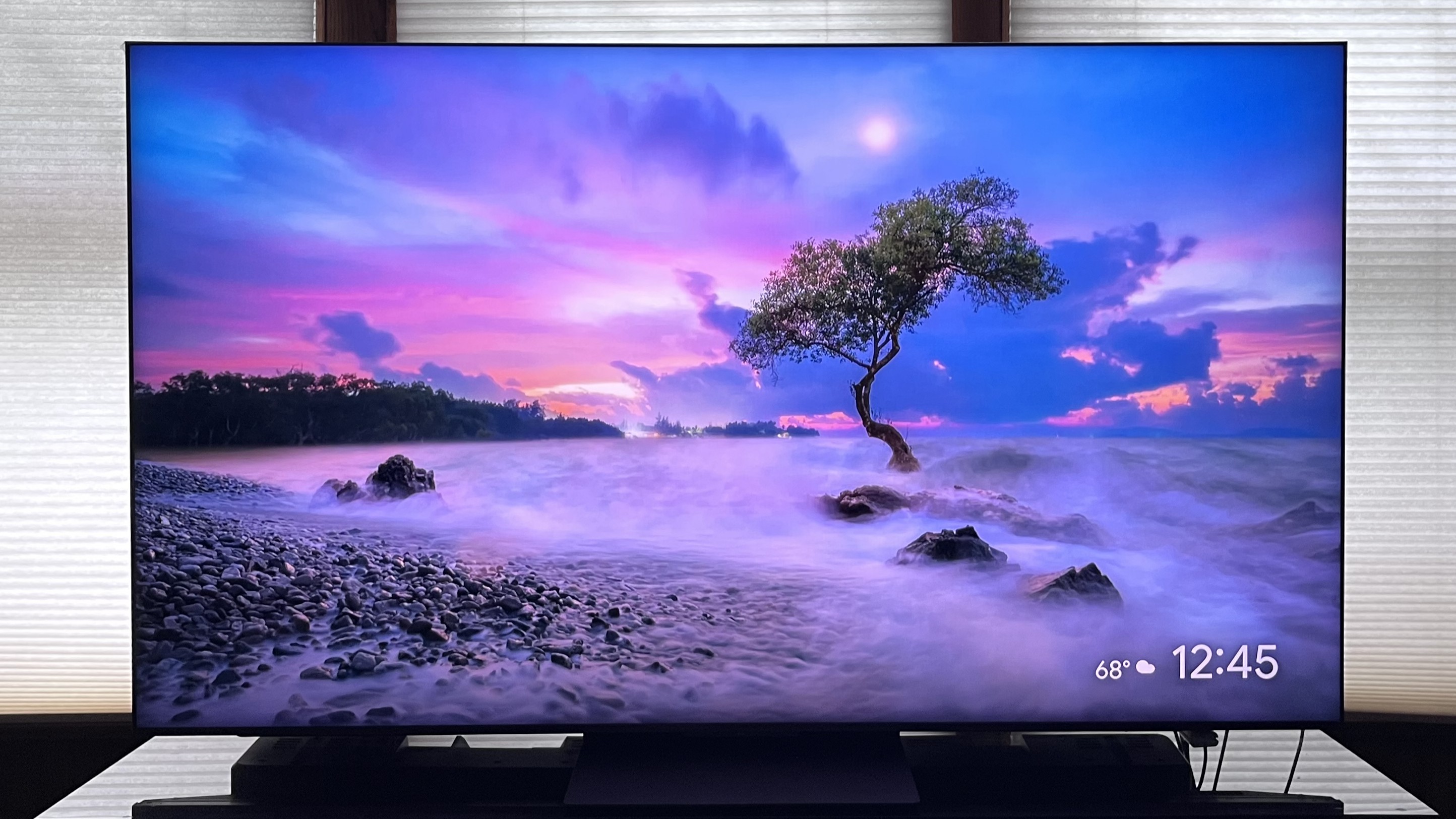
Motion handling on the QM8K was average, with a reference scene from the James Bond film No Time to Die showing a fair amount of blur and judder as Bond traversed a rocky hillside cemetery. Selecting the Custom Motion Clarity option in the Motion menu and setting both the judder and blur settings to 2 reduced this, however, and it didn’t add any soap opera effect to the picture in the process.
The QM8K’s anti-reflection screen proved effective when viewing with bright overhead room lights turned on. I could see mirror-like reflections when a lamp was placed in the way of its screen, but otherwise, general ambient room lighting didn’t harm picture contrast, even when watching movies.
Equally impressive is the QM8K’s Ultra Wide Viewing Angle feature. During my testing, pictures retained their contrast and color saturation even when viewed from a far-off-center seat. That’s a big step up from last year’s QM851G, which performed poorly in the same test.
Less impressive was a faint vignetting, an effect that is likely related to the QM8K’s Zero Border design, which places the LCD panel driver circuitry along the outer edges of the screen. The effect was minor, and I mostly saw it only on gray full-field test patterns during my initial testing, but during normal viewing, I occasionally noted it on flat fields of color, such as an empty blue sky.
- Picture quality score: 4.5/5
TCL QM8K review: Sound quality
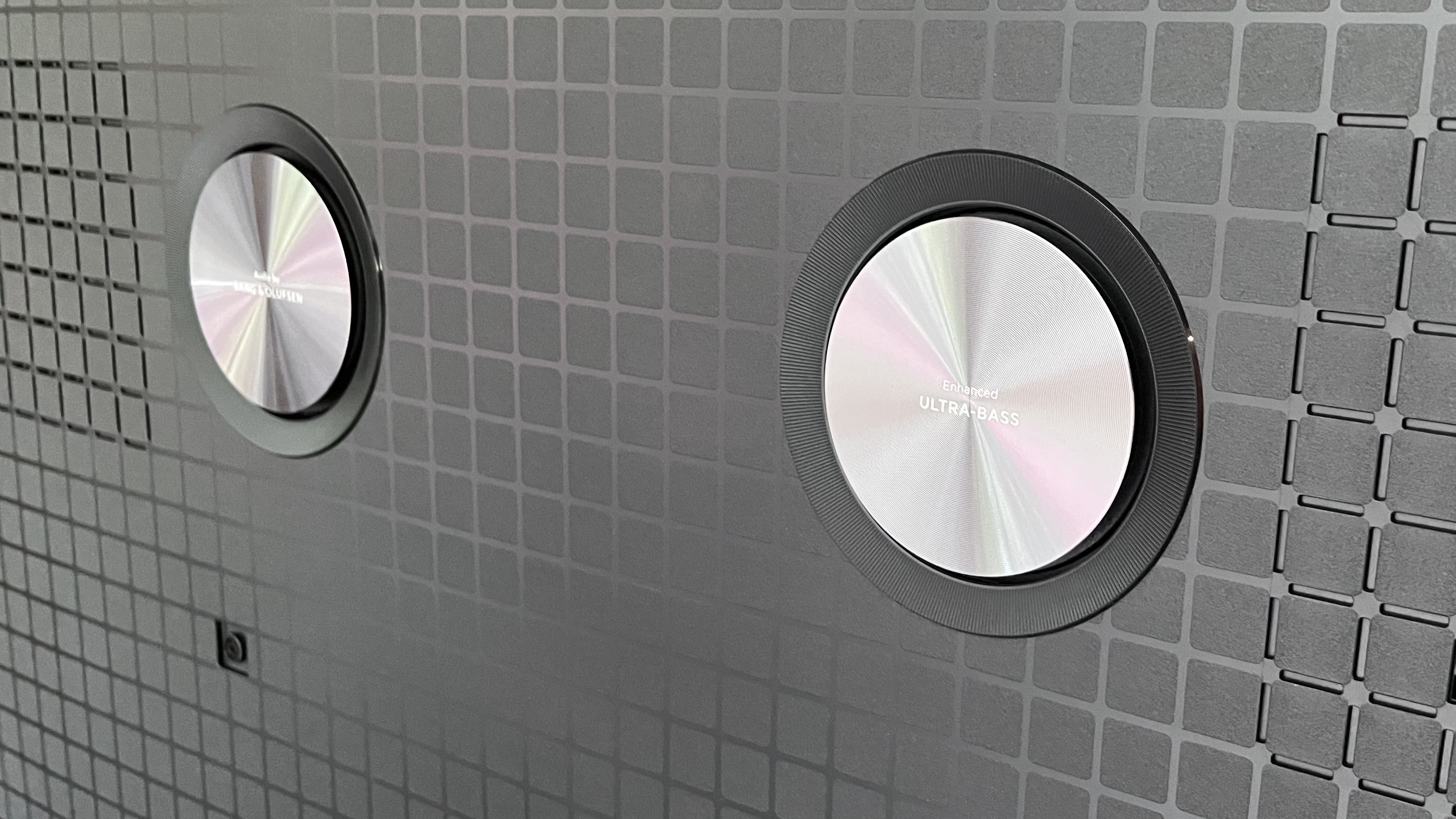
- Dolby Atmos and DTS Virtual:X
- Audio by Bang & Olufsen built-in speakers
- Good overall sound quality
The QM8K’s Audio by Bang & Olufsen built-in speakers support both Dolby Atmos and DTS Virtual:X. TCL doesn’t provide any specs about speaker configuration or power, but there are upfiring drivers on the TV’s top surface, and bass modules on the back panel.
Sound features are mostly limited to presets such as Speech, Movies, Game, and Night. There’s also a Custom preset that lets you make adjustments using Bang & Olufsen’s Beosonic interface, which involves moving a cursor between Relaxed, Energetic, Bright, and Warm options until you settle on a sonic mix that you like. Using this, I found it useful for taking off the bright edge that’s typical for built-in TV sound.
I did most of my viewing using the TV’s Movie preset, which provided a good level of spaciousness with Dolby Atmos soundtracks while retaining speech clarity. The QM8K’s sound was good overall, with accurate positioning, but bass was limited, and soundtracks could also get a bit muddied when pushed to higher volume levels. Movie fans will want to consider pairing the QM8K with one of the best soundbars.
- Sound quality score: 4/5
TCL QM8K review: Design
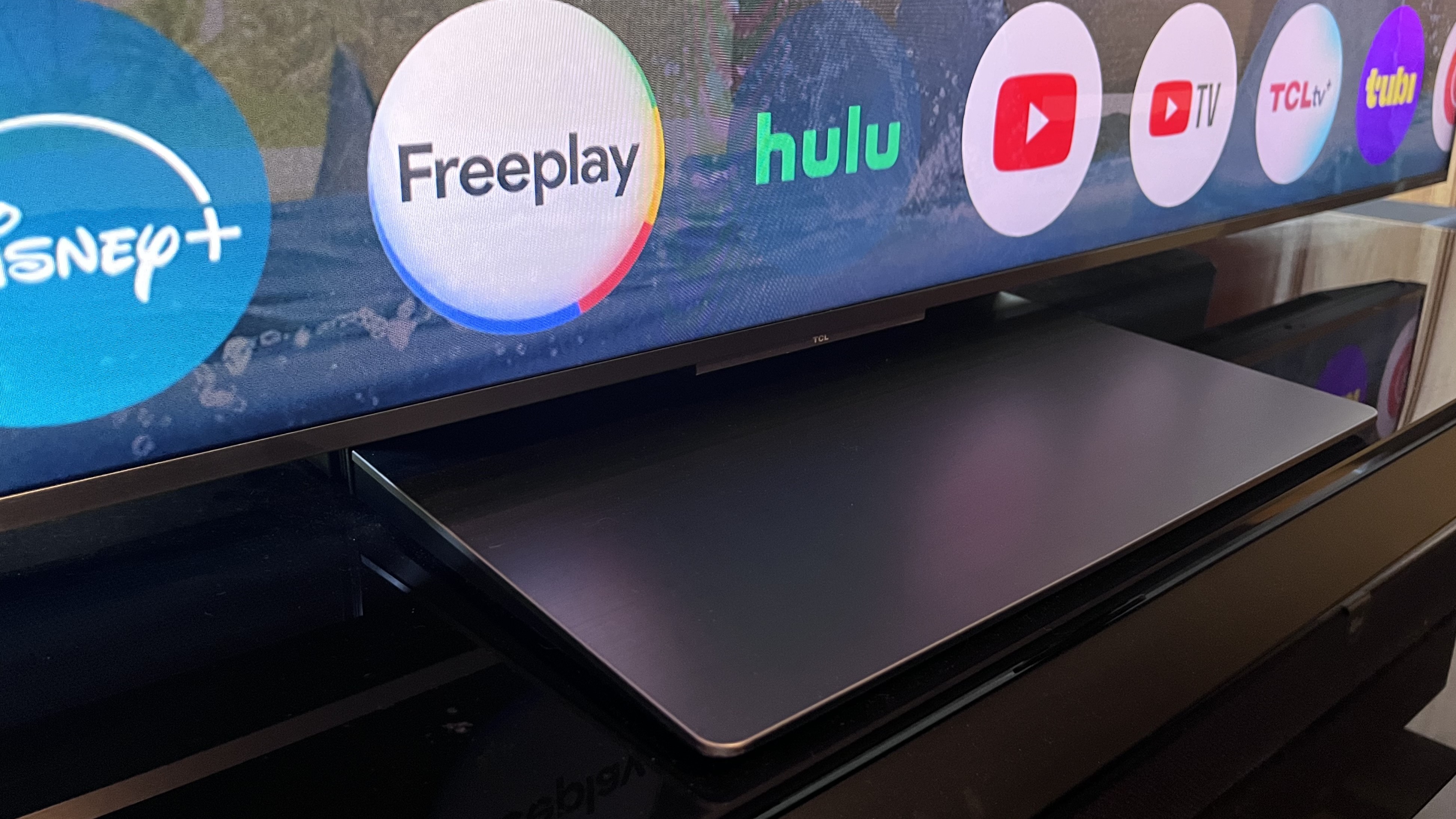
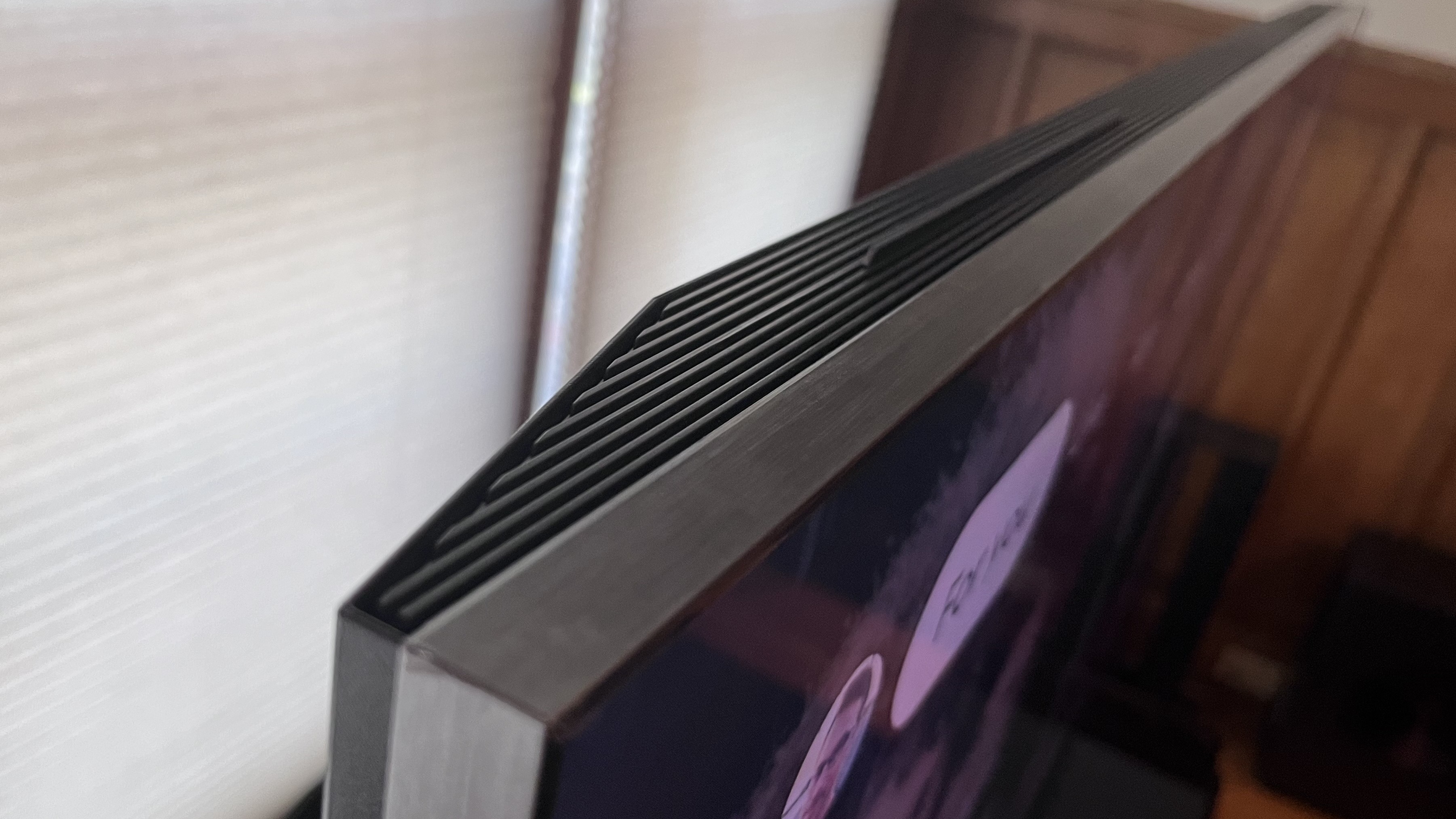
- Ultra Slim design
- Adjustable height pedestal stand
- Full-sized, backlit remote control
The QM8K’s “Ultra Slim” design features a sloping back panel that gives the impression the TV is thinner than it actually is. A sturdy plastic-capped aluminum pedestal stand is used for all sizes except the 98-inch model, and it has an adjustable height to clear space for a soundbar. Many TVs claim to have a “bezel-free’ design, but the QM8K with its 3.4mm, Zero Border bezel comes closer to presenting an all-image look than most I’ve seen.
Connections are located on a side-mounted input section and include four HDMI ports (including one with eARC and two HDMI 2.1 with 4K 144Hz support), an optical digital audio output, RF antenna, two USB type-A, and Ethernet.
TCL’s remote control strikes a nice balance between the more minimalist ones that come with TVs from LG and Samsung and the button-heavy remotes included with Hisense TVs. The buttons are backlit so you can actually see what you’re doing in the dark, and there are dedicated controls for input selection and for accessing Netflix, Prime Video, YouTube, and the ad-supported TCLTV free streaming channels portal.
- Design score: 4/5
TCL QM8K review: Smart TV and menus
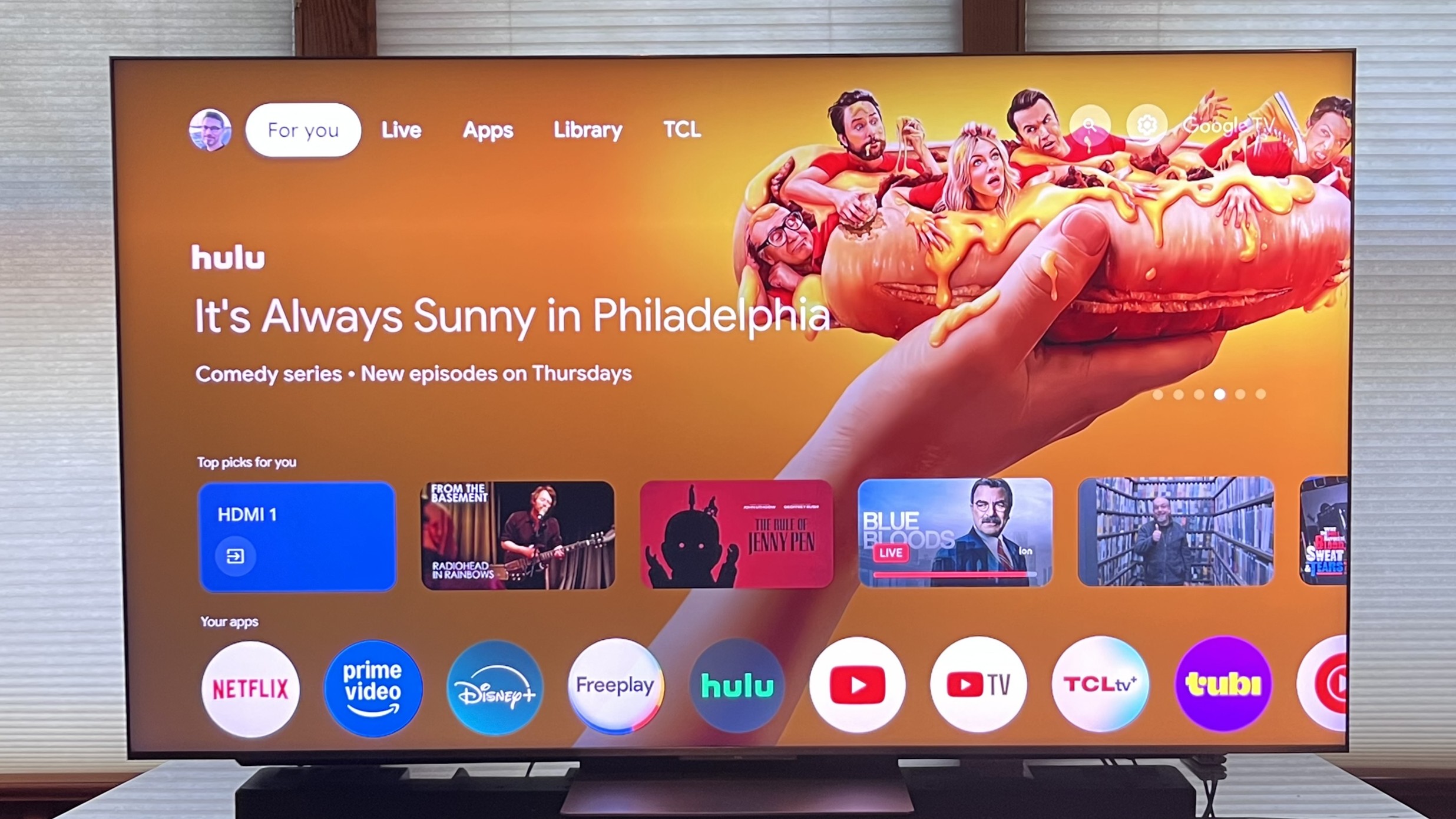
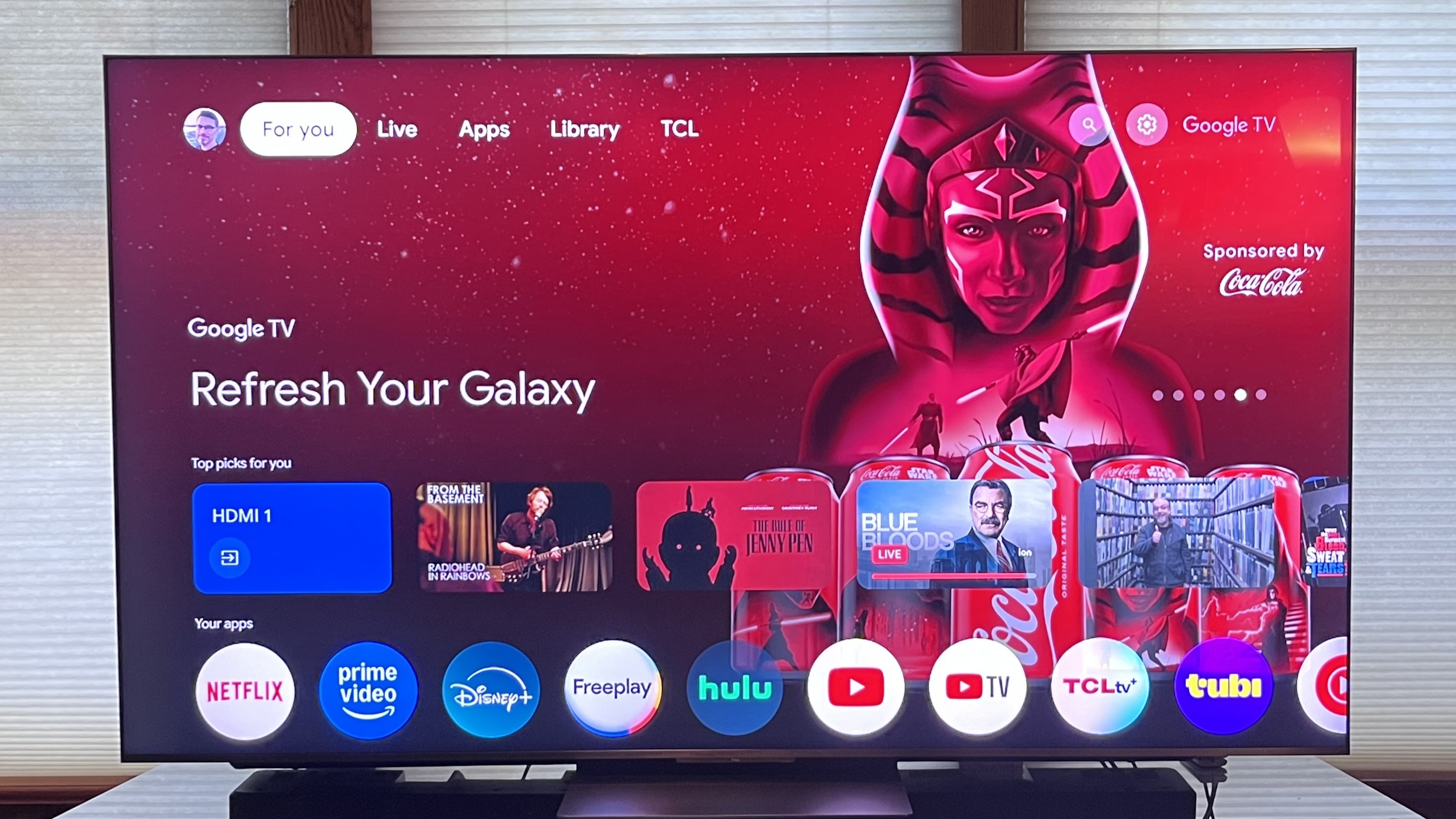
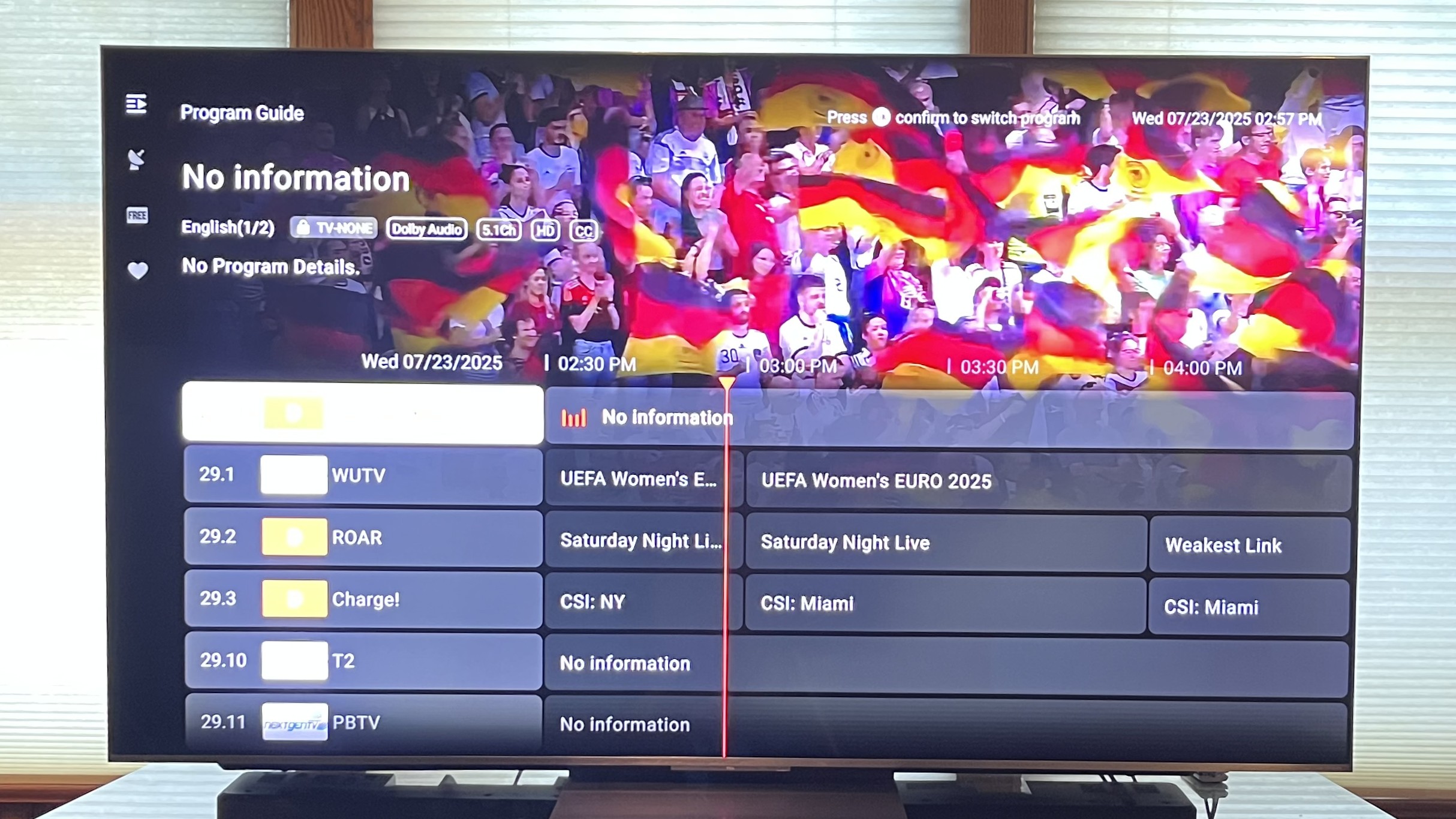
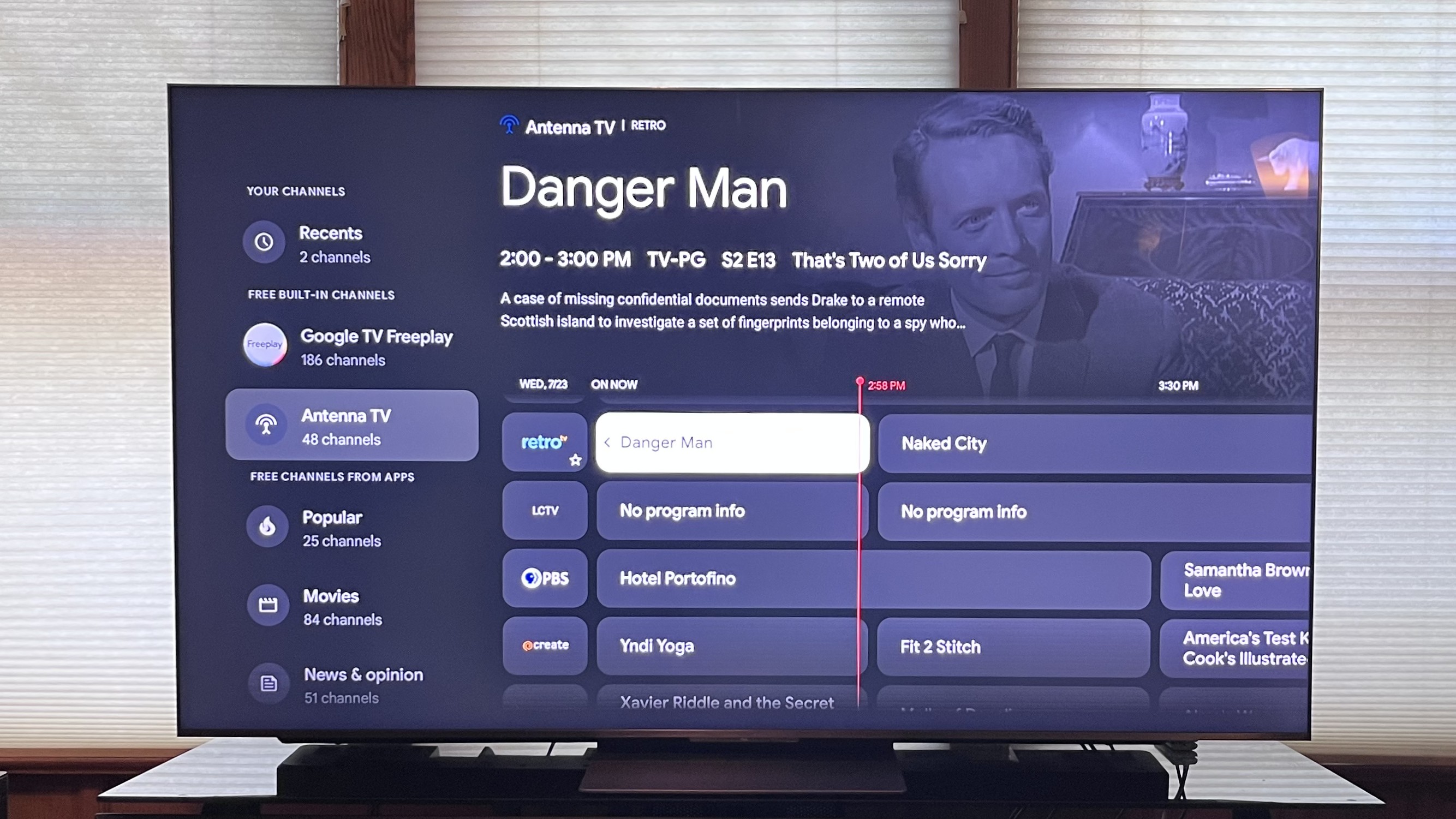
- Google TV
- Live program grid integrates FAST and broadcast channels
- Quick settings menu
TCL TVs use the Google TV smart TV platform, which features a homescreen with a large banner at the top with rotating show recommendations and a few sponsored ads. A ‘Top picks for you’ row of recommended programs is located directly below, and the options can be determined by your Google search activity and viewing history when you’ve signed in with a Google account. The final component of the homescreen is a ‘Your apps’ row at the bottom of the screen, which can be edited to reflect your most-used apps.
Tabs located at the top of the homescreen let you access the following: Live (a program guide with Google TV Freeplay channels and channels pulled in by antenna), Apps (a portal for downloading and organizing apps), Library (for purchasing and renting shows and movies on Google TV), and TCL (TCL’s own TCLtv free, ad-supported channels).
As usual with Google TV, picture adjustments and other settings can be accessed by clicking the gear icon onscreen, or its equivalent on the remote control. There are a fair number of adjustments available, including advanced ones such as 2- and 20-point white balance and variable gamma settings.
A quick menu can also be accessed via a dedicated remote control button, and this presents an overlay at the bottom of the screen for easy access to a range of settings, including essential ones like brightness and picture mode.
- Smart TV & menus score: 4/5
TCL QM8K review: Gaming
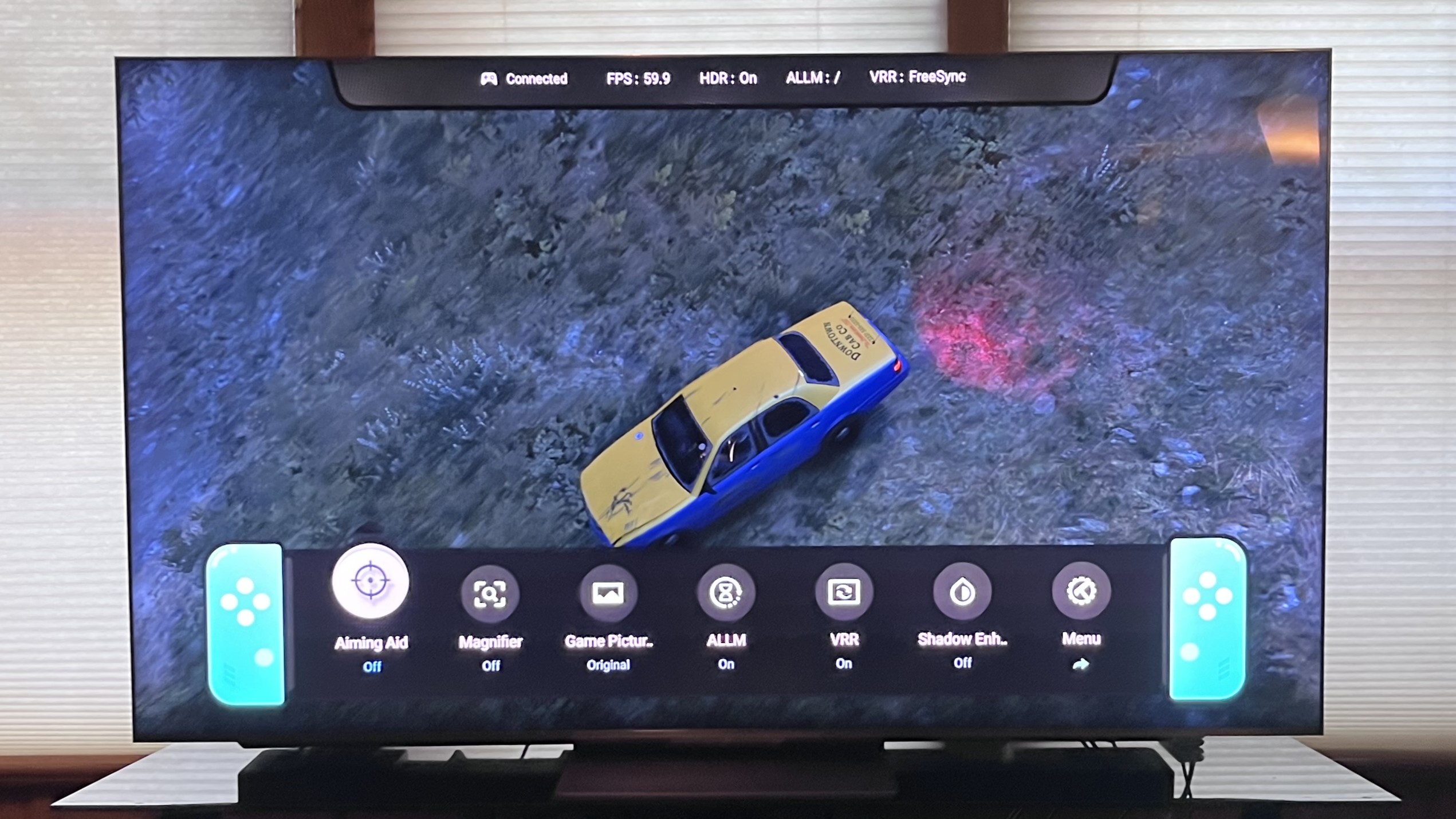
- Two HDMI 2.1 ports with 4K 144Hz support
- Game Accelerator 288 VRR
- 13.2ms input lag is an average level for TVs
Gaming features on the QM8K include two HDMI 2.1 ports with support for 4K 144Hz, ALLM, and FreeSync Premium Pro. There’s also a Game Accelerator 288 VRR feature that doubles the TV’s native 144Hz refresh rate for 1080p-resolution gaming (which may be of interest to PC gamers), and an onscreen Game Menu that lets you make quick gaming-related adjustments without having to exit the main screen.
I measured the QM8K’s input lag in Game mode at 13.2 using a Bodnar 4K meter. That’s an average level, and below the 15ms threshold most gamers look for, but other TVs we’ve recently tested from Samsung and LG, and also the new Hisense U8QM, yielded under 10ms lag times when we measured them.
- Gaming score: 4/5
TCL QM8K review: Value
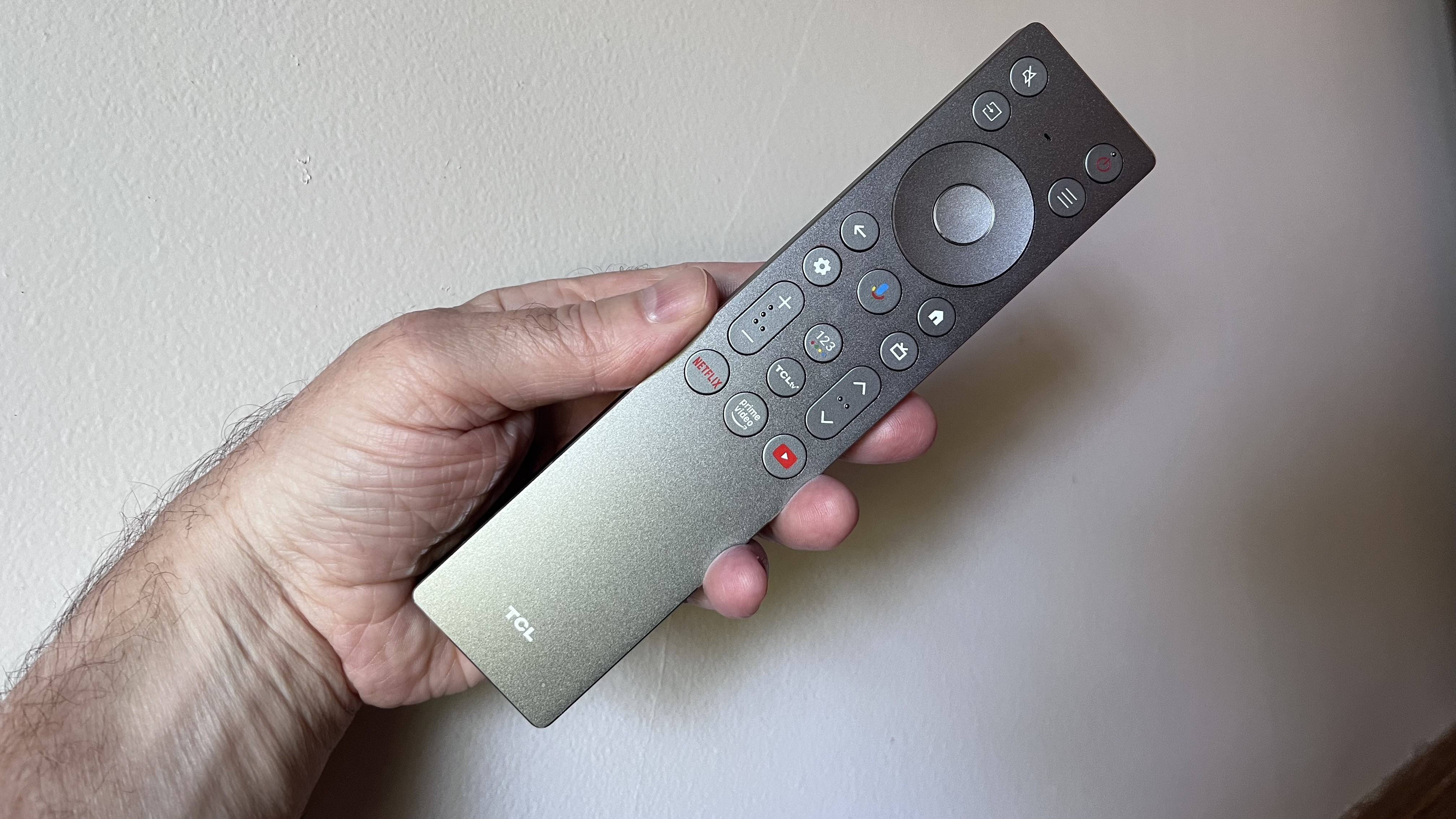
- Great value at current price
- Cheaper options available with similar brightness
- You’ll pay considerably more for premium brand options
At its current reduced $1,599 price for the 65-inch model I tested, the TCL QM8K is an excellent value.
That price is more than what you’ll pay for the Hisense U8QG, that company’s flagship model, but the TCL arguably has better overall picture quality and also better built-in sound. It’s also less than what you’ll pay for the Samsung QN90F, another flagship mini-LED, and one that offers a better smart TV platform and gaming features, along with a slimmer design.
Taking all that into consideration, the TCL is a solid middle mini-LED option, and perhaps the best value of the three.
- Value score: 4.5/5
Should I buy the TCL QM8K?
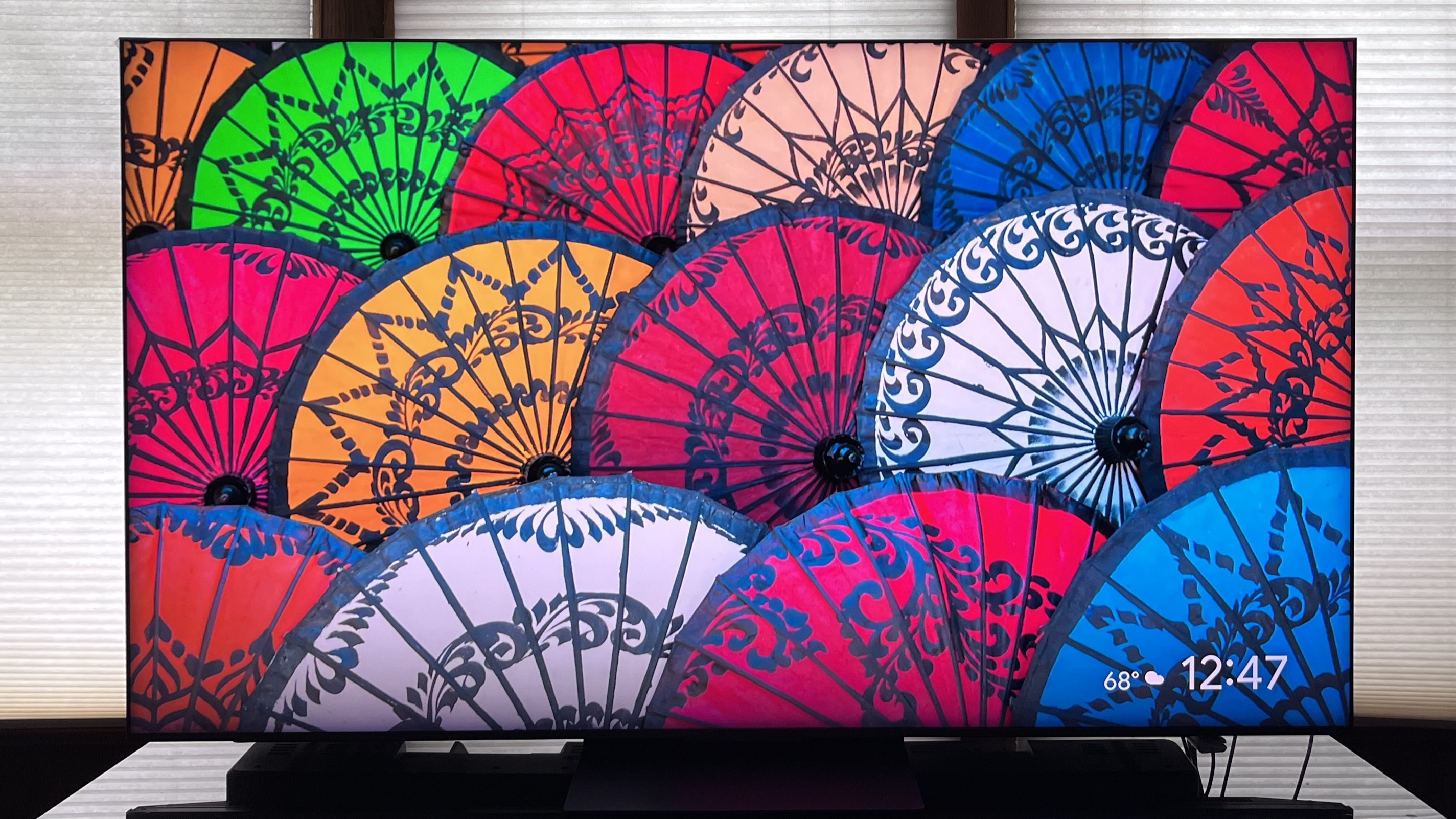
Attributes | Notes | Rating |
|---|---|---|
Features | Comorehensive HDR support and Audio by Bang & Olufsen built-in speakers | 4.5/5 |
Picture quality | High brightness, refined local dimming, an anti-reflective screen, and a wide viewing angle make this a great all-purpose TV | 4.5/5 |
Sound quality | Good overall sound quality but limited bass. A Beosonic interface allows for fine-tuning audio | 4/5 |
Design | A literally bezel-free design with a sturdy pedestal stand and solid, backlit remote control | 4/5 |
Smart TV and menus | Google TV is a serviceable smart interface plus the quick menu provides easy access to basic settings | 4/5 |
Gaming | 4K 144Hz and FreeSync Premium Pro supported, but only on two HDMI ports | 4/5 |
Value | At its current discounted price, the QM8K is a great value | 4.5/5 |
Buy it if...
You want a great TV for movies
The QM8K’s high brightness, refined local dimming, and comprehensive HDR format support make it an excellent choice for watching 4K movies.
You also want a great TV for sports
An anti-reflection screen on the QM8K effectively reduces screen glare during daytime sports viewing, and an Ultra Wide Angle feature means its picture looks solid even from off-center seats.
You don’t want to pay top dollar for a mini-LED TV
The QM8K offers much the same performance level as other flagship mini-LED TVs from brands like Samsung, while costing several hundred dollars less.
Don't buy it if…
You want the best gaming TV
While the QM8K has a strong set of gaming features, including 4K 144Hz and FreeSync Premium Pro support, those features are only supported on two of its HDMI ports. Also, there are other TVs with lower input lag time than the TCL.
You want the best smart TV platform
Google TV is a generic, serviceable smart TV platform, but it's been eclipsed by the smart platforms on LG and Samsung TVs, which have seen strong improvements over the past few years.
You want to watch movies, but don’t want a soundbar
The QM8K has good built-in sound, but movie soundtracks can get congested at loud listening levels, making a soundbar a necessity for best audio quality.
TCL QM8K: Also consider...
| Header Cell - Column 0 | TCL QM8K | Samsung QN90F | Hisense U8QG | Sony Bravia 9 |
|---|---|---|---|---|
Price (65-inch) | $2,499.99 | $2,499.99 | $2,199 | $2,999 |
Screen type | QLED w/ mini-LED | QLED w/ mini-LED | QLED w/ mini-LED | QLED w/ mini-LED |
Refresh rate | 144Hz | 165Hz | 165Hz | 144Hz |
HDR support | DolbyVision/HDR10+/HDR10/HLG | HDR10+/HDR10/HLG | DolbyVision/HDR10+/HDR10/HLG | DolbyVision/HDR10/HLG |
Smart TV | Google TV | Tizen | Google TV | Google TV |
HDMI ports | 4 (2x HDMI 2.1) | 4x HDMI 2.1 | 3x HDMI 2.1 | 4 (2x HDMI 2.1) |
Samsung QN90F
The QN90F is pricier than the QM8K, but it has better gaming features and performance and a superior smart TV platform. Its Glare Free screen is also more effective at reducing reflections in bright rooms.
Here’s our Samsung QN90F review
Hisense U8QG
Hisense’s flagship mini-LED TV is currently a cheaper option than the TCL QM8K. It has a similarly bright picture plus refined local dimming, but it lacks the QM8K’s Ultra Wide Angle feature and has less impressive built-in speakers.
Here’s our Hisense U8QG review
Sony Bravia 9
The Sony Bravia 9 is significantly more expensive than the other TVs listed here, but it has a bright picture with refined local dimming plus excellent built-in sound and audio-related features.
Here’s our Sony Bravia 9 review
How I tested the TCL QM8K
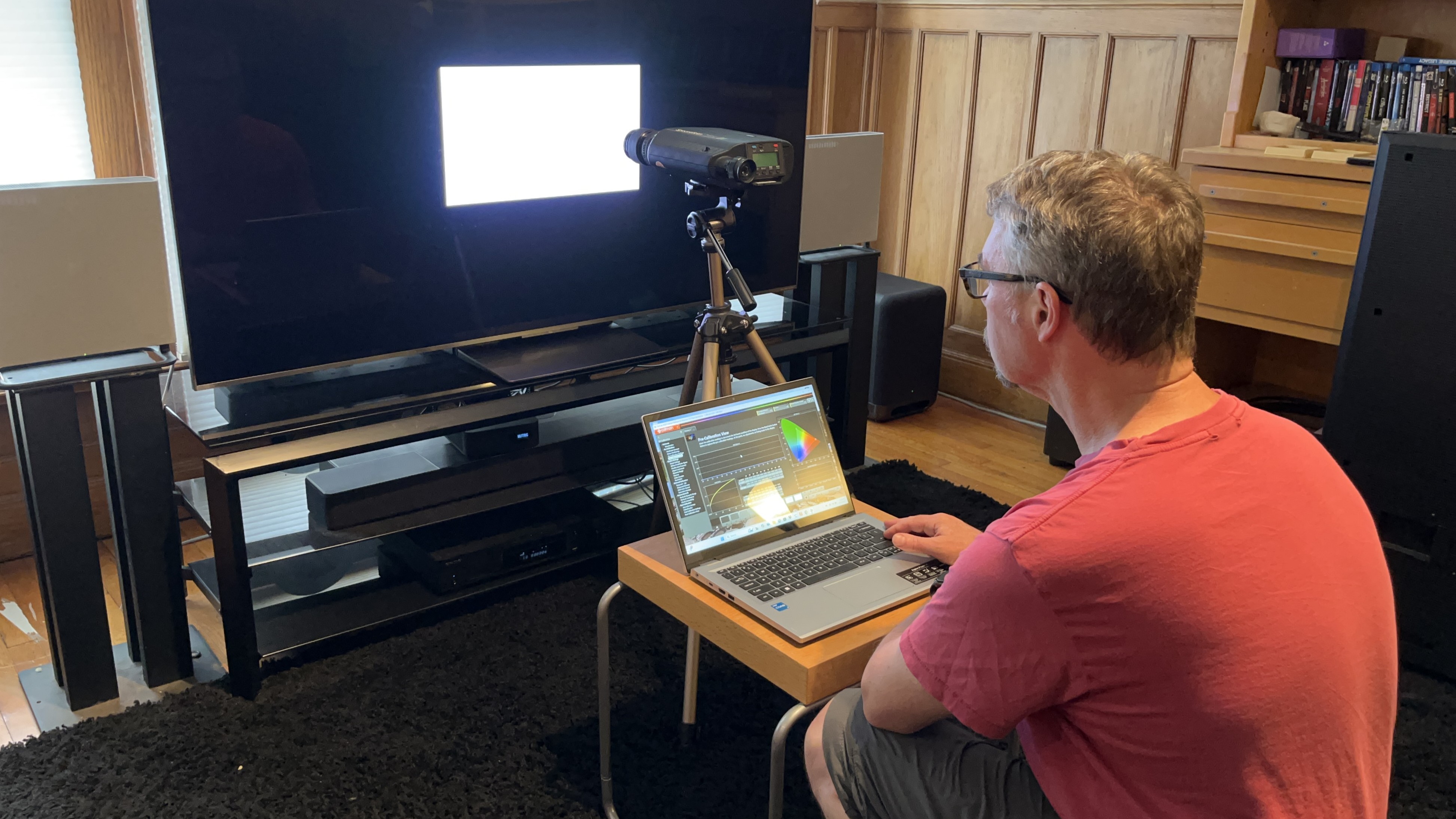
- I spent about 15 viewing hours in total measuring and evaluating
- Measurements were made using Calman color calibration software
- A full calibration was made before proceeding with subjective tests
When I test TVs, I first spend a few days or even weeks using it for casual viewing to assess the out-of-the-box picture presets and get familiar with its smart TV menu and picture adjustments.
I next select the most accurate preset (usually Filmmaker Mode, Movie or Cinema) and measure grayscale and color accuracy using Portrait Displays’ Calman color calibration software. The resulting measurements provide Delta-E values (the margin of error between the test pattern source and what’s shown on-screen) for each category, and allow for an assessment of the TV’s overall accuracy.
Along with those tests, I make measurements of peak light output (recorded in nits) for both standard high-definition and 4K high dynamic range using 10% and 100% white window patterns. Coverage of DCI-P3 and BT.2020 color space is also measured, with the results providing a sense of how faithfully the TV can render the extended color range in ultra high-definition sources – you can read more about this process in our guide to how we test TVs at TechRadar.
For the TCL QM8K, I used the Calman ISF workflow, along with the TV’s advanced picture menu settings, to calibrate the image for best accuracy. I also watched a range of reference scenes on 4K Blu-ray discs to assess the TV’s performance, along with 4K HDR shows streamed from Max, Netflix, and other services.
- First reviewed: July 2025
- Read TechRadar's reviews guarantee

Al Griffin has been writing about and reviewing A/V tech since the days LaserDiscs roamed the earth, and was previously the editor of Sound & Vision magazine.
When not reviewing the latest and greatest gear or watching movies at home, he can usually be found out and about on a bike.
You must confirm your public display name before commenting
Please logout and then login again, you will then be prompted to enter your display name.
